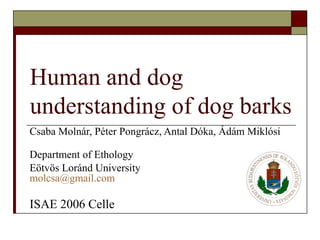
Human and dog understanding of dog barks
- 1. Human and dog understanding of dog barks Csaba Molnár, Péter Pongrácz, Antal Dóka, Ádám Miklósi Department of Ethology Eötvös Loránd University molcsa@gmail.com ISAE 2006 Celle
- 2. Bark as a communicative signal the main difference between the vocal repertoires of dogs and wild canids is the frequency of occurrence of bark (Feddersen-Petersen 2000) only a few studies focused on the acoustic communication of dogs (e. g. Fox & Cohen 1976) assumed that as a result of domestication barking has lost its role in communication (e. g. Tembrock 1976) bark is characterized by a few context- (motivational state) specific acoustic parameters (Yin 2002)
- 3. Human understanding of bark humans can associate the barks with appropriate emotional contents they have the ability to categorize barks into various contexts people with different dog experience levels showed similar trends (Pongrácz et al 2005) congenitally blind people performed similarly as sighted people (Molnár et al 2006a in prep)
- 4. Emotional scores given by listeners Stranger 4 3 Play Fight aggressiveness 2 fear despair 1 playfulness happiness Ball Walk Non-owners Alone Pongrácz et al. 2005
- 5. the way humans describe the emotions in barks parallels motivational-structural rules of animal acoustics (Morton 1977, Pongrácz et al 2006 in press) humans showed only modest accuracy in discriminating between individuals of dogs by only hearing their barks (Molnár et al 2006b in press) a computerized algorithm for categorizing barks seems to perform better than humans (Molnár et al 2006c in prep)
- 6. A playback study with dogs the habituation-discrimination paradigm phase 1: the same stimulus three times (habituation) expected change: the behavioural response declines phase 2: a ‘new’ stimulus (dishabituation) expected change: if the subject discriminates between the new and previous stimuli then response increases References: Janik, Rey 2002 (dolphin), Masataka 1985 (Japanese monkey), Hauser 1998 (Rhesus), Zuberbühler 2002 (Diana monkey)
- 7. The scheme of the paradigm stimuli ‘A’ stimulus ‘B’ habituation dishabituation magnitude Response time 1 2 3 4 trials
- 8. Questions Experiment 1: Are dogs able to discriminate between barks recorded in two different contexts? Experiment 2: Are dogs able to discriminate between the same barks if recorded from two different individuals?
- 9. Method Subjects: family dogs, N=90 (test groups: N1,2=30; control group: N=30) Stimuli: barks at a stranger intruding the garden barks while leashed to a tree and left alone (all barks recorded from Mudis) duration of orientation toward the speaker owner is present during the experiment Stranger Alone
- 10. Experimental room layout computer, recorder, monitor microphone owner and dog camera camera camera and speaker
- 12. Results 1: Discrimination between contexts 12 * 10 orientation time (s) ± SE 8 6 NS NS 4 ** 2 NS 0 *** 1 2 3 4 stimuli control (4th stimulus is the same), N=30 test (4th stimulus is different), N=30 RM ANOVAs (Molnár et al 2006d in prep)
- 13. Results 2: Discrimination between individuals NS 10 9 orientation time (s) ± SE 8 7 6 NS 5 *** NS 4 NS 3 2 1 0 *** 1 2 3 4 stimuli control (4th stimulus is the same), N=30 test (4th stimulus is different), N=30 RM ANOVAs (Molnár et al 2006d in prep)
- 14. Conclusion Dogs are able to discriminate between barks recorded in different contexts They are also able to distinguish between barks of different individuals Their performances are not influenced by the contexts of the habituation stimuli
- 15. Suggested research directions Are dogs able to discriminate between barks of familiar and unfamiliar individuals? Can they distinguish the barks of different dog breeds? Is it possible to teach dogs to recognize barks?
- 16. Acknowledgements The authors are thankful to the members of Hungarian Mudi Club for their assistance to the sound recordings Claudia DeRosa and other members of research staff at Department of Ethology for their help in recruiting subjects This study was funded by the grants of the Hungarian Ministry of Education: FKFP No. 127/2001, and Hungarian NSF No. T047235
